|
|

|
|
Author
|
Topic: Orion EFT-1: Underway Recovery Test (Feb. 2014)
|
Robert Pearlman
Editor Posts: 50516
From: Houston, TX
Registered: Nov 1999
|
 posted 12-13-2013 09:35 AM
posted 12-13-2013 09:35 AM
   
NASA release NASA's Orion Spacecraft Heads Cross CountryA test version of NASA’s Orion spacecraft gears up to take a long road trip. Starting from NASA’s Langley Research Center in Hampton, Va., the mockup will take a four-week journey across the nation to Naval Base San Diego in California. There, the test article will be used to support NASA’s Underway Recovery Test in February 2014. The test will simulate the recovery of Orion during its first mission, Exploration Flight Test-1 (EFT-1), scheduled for September 2014. 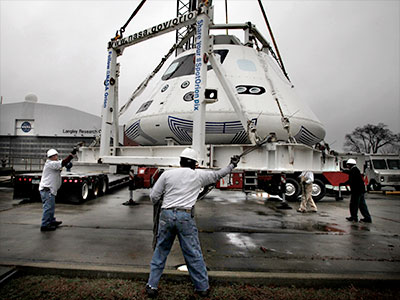 The uncrewed EFT-1 mission will take Orion to an altitude of approximately 3,600 miles above the Earth’s surface, reentering the atmosphere at a speed of over 20,000 miles per hour before landing in the Pacific Ocean. During the recovery test in San Diego, the spacecraft will be set adrift in open and unstable waters, providing NASA and the Navy the opportunity to recover the capsule into the well deck of the USS San Diego. While deployed, the team will seek out various sea states in which to practice the capsule recovery procedure in an effort to build their knowledge base of how the capsule recovery differs in calm and rough seas and what are the true physical limits. NASA and the Navy practiced recovery in calm seas during a Stationary Recovery Test in August where the spacecraft was set adrift in the waters of Naval Station Norfolk in Virginia and recovered into the docked well deck of the USS Arlington. 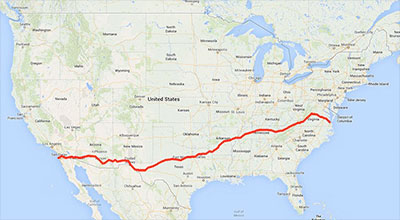 The Orion mockup will travel through Virginia, Tennessee, Arkansas, Texas, New Mexico, Arizona and then reach its final destination in California. The Orion mockup departed Langley Research Center on Dec. 11. |
Robert Pearlman
Editor Posts: 50516
From: Houston, TX
Registered: Nov 1999
|
 posted 02-20-2014 12:03 PM
posted 02-20-2014 12:03 PM
   
NASA photo release NASA and the Navy are conducting tests to prepare for recovery of Orion after it splashes down in the Pacific Ocean at the end of its first space flight, Exploration Flight Test-1, in September. Tests with the USS San Diego off the coast of San Diego Feb. 18-21, 2014, will allow teams to demonstrate and evaluate the processes, procedures, hardware and personnel that will be needed for recovery operations.
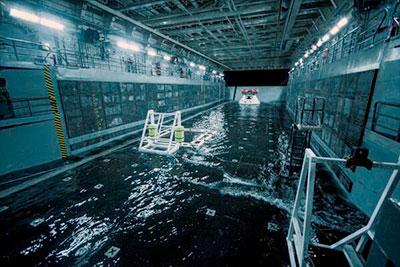 |
Robert Pearlman
Editor Posts: 50516
From: Houston, TX
Registered: Nov 1999
|
 posted 02-21-2014 11:16 AM
posted 02-21-2014 11:16 AM
   
NASA release Orion testing provides lessons and data for splashdown recovery operationsThe first full joint testing between NASA and the U.S. Navy of Orion recovery procedures off the coast of California was suspended after the team experienced issues with handling lines securing a test version of Orion inside the well deck of the USS San Diego. NASA and the Navy were conducting tests to prepare for recovery of Orion after it splashes down in the Pacific Ocean at the end of its first space flight, Exploration Flight Test-1, in September. The testing was planned to allow teams to demonstrate and evaluate the processes, procedures, hardware and personnel that will be needed for recovery operations. 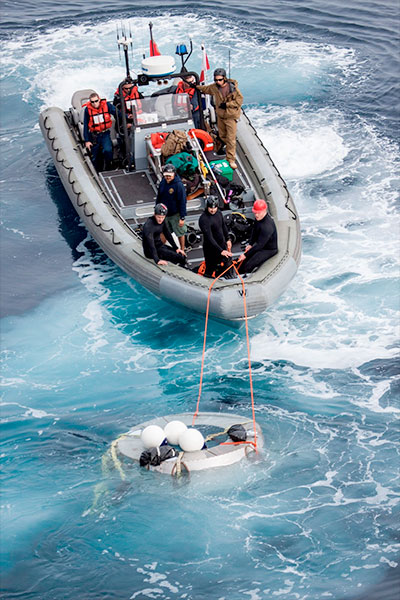 Above: Members of the Orion recovery team work to retrieve a test version of Orion's forward bay cover, a protective shell that fits on the crew module, from the Pacific Ocean on Feb. 19. The lines were unable to support the tension caused by crew module motion that was driven by wave turbulence in the well deck of the ship. The team called off the week's remaining testing to allow engineers to evaluate next steps. The challenges that arose demonstrate why it is important to subject Orion to tests in the actual environments that the spacecraft will encounter. "Even though the testing didn't go as we had planned, we're learning lessons that will help us be better prepared to retrieve Orion after it travels more than 3,600 miles into space and comes home," said Bill Hill, assistant deputy associate administrator for exploration systems development at NASA Headquarters in Washington. "The Orion testing work we do is helping us work toward sending humans to deep space." The testing has provided important data that is being used to improve recovery procedures and hardware ahead of Orion's first flight test this fall. Several of the test objectives were accomplished before the remaining tests were called off, including successful recoveries of the forward bay cover, parachute and demonstrations of the coordination required between the team onboard the ship and mission control in Houston. Orion is America's new spacecraft that will take astronauts to destinations not yet explored by humans, including an asteroid and Mars. It will have an emergency abort capability, sustain the crew during space travel and provide safe re-entry from deep space. During Exploration Flight Test-1, an uncrewed spacecraft will travel 15 times farther than the International Space Station before returning to Earth at speeds as fast as 20,000 mph and temperatures above 4,000 degrees Fahrenheit to evaluate the spacecraft's heat shield and other systems. |
JBoe
Member Posts: 993
From: Edgewater, MD
Registered: Oct 2012
|
 posted 02-22-2014 07:13 AM
posted 02-22-2014 07:13 AM
   
USS San Diego's website has listed all the units involved in the recovery test. They include: - Helicopter Sea Combat Squadron (HSC) 8 - air support, observation, and documentation
- Explosive Ordnance Disposal Mobile Unit Three - provided divers
- Fleet Weather Center San Diego - monitoring sea and weather conditions
- And of course LPD-22 (USS San Diego) sailors that operated the small boats/zodiacs and well deck operators
|
Robert Pearlman
Editor Posts: 50516
From: Houston, TX
Registered: Nov 1999
|
 posted 08-04-2014 12:02 PM
posted 08-04-2014 12:02 PM
   
NASA photo release Underway Recovery Tests for NASA's Orion SpacecraftA test version of NASA's Orion spacecraft floats inside the well deck of the U.S.S. Anchorage on Aug. 2, 2014, during recovery tests off the coast of California. A combined NASA and U.S. Navy team practiced recovery techniques over the weekend, in preparation for Orion's first trip to (and return from) space in Exploration Flight Test-1 (EFT-1) in December. 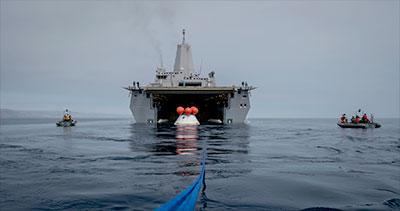 Additional details from a NASA preview article: URT 2 will pick up where URT 1 left off. During that first underway recovery test in February, dynamic conditions caused activities to conclude before all of the test objectives were met. Since then, the team has been working on concepts that would allow them to safely recover Orion despite such conditions. "During this test, the team will investigate alternative procedures and recovery methods," said Mike Generale, Orion Recovery Operations manager and Recovery Test director at NASA's Kennedy Space Center in Florida. "One of the goals of the test is to have a primary and alternate means of recovering the Orion crew module for Exploration Flight Test-1 later this year." The data gathered during Exploration Flight Test-1 will influence design decisions, validate existing computer models and innovative new approaches to space systems development, and reduce overall mission risks and costs for later Orion flights. The recovery of the vehicle is one of the things the flight will test, and the underway recovery tests prepare the combined NASA, Lockheed, and U.S. Navy team for the task. For URT 2, the Orion test vehicle will be loaded into the well deck of the USS Anchorage (LPD 23), and the team will head out to sea, off the coast of San Diego, in search of sea conditions to support test needs. New support equipment developed for URT 2 will accompany the test vehicle. New hardware includes an air bag system for the Crew Module Recovery Cradle and a load-distributing collar for placement around the crew module. The Prototype Laboratory at Kennedy designed a new device called the Line Load Attenuation Mechanical Assembly (LLAMA) that limits the tending-line forces for the Navy line handlers as Orion is guided into the ship's well deck. Tending line snubbers, a kind of commercially available rubber shock absorbers sailors use for tending lines, also will be tested. In case the seas are too rough to secure the crew module in the recovery cradle and a contingency recovery is needed, a set of rubber bumpers were developed to provide a mat on the deck of the recovery ship for use. A lifting sling will be on hand for recovery by crane. "Each of the new pieces of hardware will be evaluated for its relative merits, and the best solutions will be tested during URT 3 in September to discover the limits of their capabilities and suitability for Orion's Exploration Flight Test-1 in December," Generale said. All of this testing ensures NASA can retrieve the Orion capsule safely because it helps the team understand how to adjust for various water conditions and contingency scenarios.
|
Robert Pearlman
Editor Posts: 50516
From: Houston, TX
Registered: Nov 1999
|
 posted 08-07-2014 06:06 AM
posted 08-07-2014 06:06 AM
   
NASA release NASA, Navy Prepare for Orion Spacecraft to Make a SplashA team of technicians, engineers, sailors and divers just wrapped up a successful week of testing and preparing for various scenarios that could play out when NASA's new Orion spacecraft splashes into the Pacific Ocean following its first space flight test in December. After enduring the extreme environment of space, Orion will blaze back through Earth's atmosphere at speeds near 20,000 mph and temperatures approaching 4,000 degrees Fahrenheit. Its inaugural journey will end in the Pacific, off the Southern California coast, where a U.S. Navy ship will be waiting to retrieve it and return it to shore. 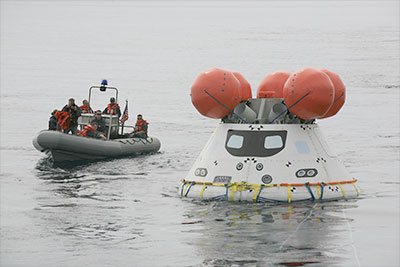 Above: U.S. Navy personnel use a rigid hull inflatable boat to approach the Orion boilerplate test article during an evolution of the Underway Recovery Test 2 in the Pacific Ocean off the coast of San Diego, California on Aug. 2, 2014. Credit: NASA/Kim Shiflett "We learned a lot about our hardware, gathered good data, and the test objectives were achieved," said Mike Generale, NASA recovery operations manager in the Ground Systems Development and Operations Program. "We were able to put Orion out to sea and safely bring it back multiple times. We are ready to move on to the next step of our testing with a full dress rehearsal landing simulation on the next test." NASA and Orion prime contractor Lockheed Martin teamed up with the U.S. Navy and the Defense Department's Human Space Flight Support Detachment 3 to try different techniques for recovering the 20,500-pound spacecraft safely during this second "underway recovery test." To address some of the lessons learned from the first recovery test in February, the team brought new hardware to test and tested a secondary recovery method that employs an onboard crane to recover Orion, as an alternative to using the well deck recovery method, which involves the spacecraft being winched into a flooded portion of the naval vessel. 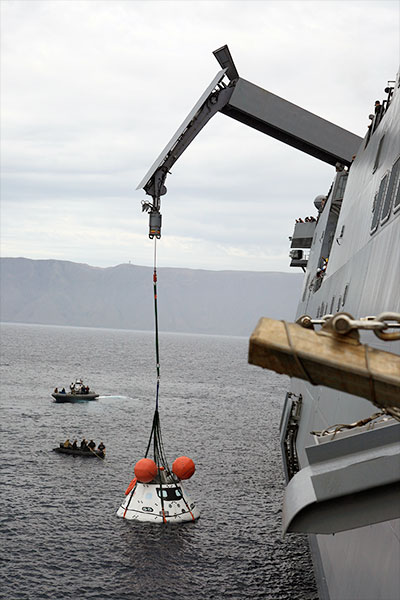 Above: The Orion boilerplate test vehicle is slightly lifted by crane from the water to test the proof of concept basket lift method during an evolution of the Underway Recovery Test 2 near the USS Anchorage in the Pacific Ocean off the coast of San Diego, California on Aug. 3, 2014. Credit: NASA/Kim Shiflett "Anchorage provided a unique, validated capability to support NASA's request for operational support without adversely impacting the Navy's primary warfighting mission," said Cmdr. Joel Stewart, commanding officer of the Navy vessel. "This unique mission gave Anchorage sailors an opportunity to hone their skills for the routine missions of recovering vehicles in the well deck and operating rigid-hulled inflatable boats in the open water while supporting NASA. The testing with NASA was a success and Anchorage sailors continue to raise the bar, completing missions above and beyond any expectations." |
E2M Lem Man
Member Posts: 846
From: Los Angeles CA. USA
Registered: Jan 2005
|
 posted 08-08-2014 04:26 PM
posted 08-08-2014 04:26 PM
   
The recovery ship and the Orion Command Module will be on display in San Pedro (CA) Aug. 9-10 for "Navy Days" celebrations. NASA folk will be on hand to answer questions.Tickets are scarce but available through Navy recruiters. | |
Contact Us | The Source for Space History & Artifacts
Copyright 2023 collectSPACE.com All rights reserved.

Ultimate Bulletin Board 5.47a
|
|

|
 advertisement advertisement

|


















